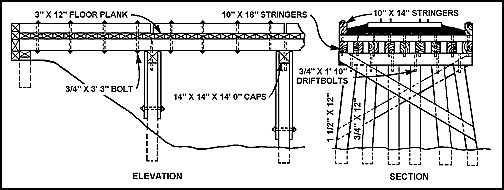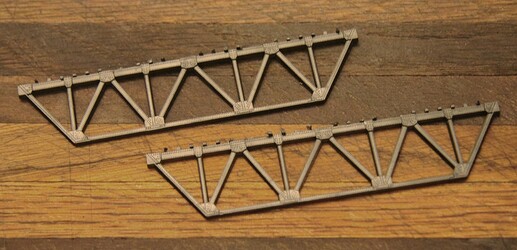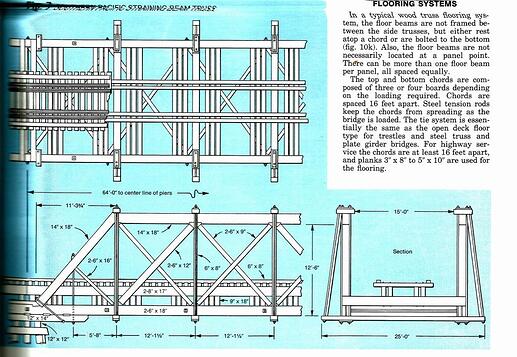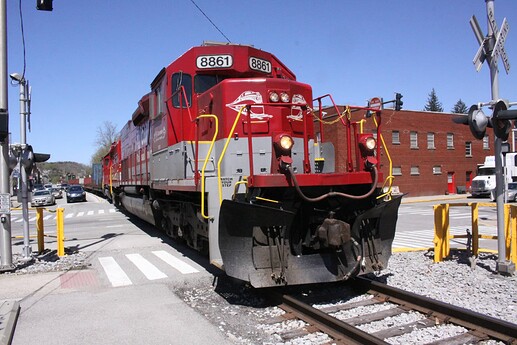But I find really interesting about this bridge are the three different abutments in pylons that it rests on.
Totally agree as to the interesting abutments which is why I thought this photo might be of interest to the Model Railroader. A different sort of structure, more varied than the usual and certainly unique. ~ Thanks
Interesting Bridge Construction images found in the online archives of the University of Kentucky, Margrette I. King Library; Lexington, Kentucky. Dated March of 1915.
The bridge crane would make for an interesting model or diorama.
Take a three drum logging skidder (donkey engine), find or build a long steel flatcar. The crane itself is certainly scratch buildable! To make it ever more impressive machine thay would sometimes run brace cables from the top of that A-frame, over the engine to attach to a second flatcar behind. That flatcar would be loaded with scrap iron and large rocks to serve as a rear counter weight so the crane could lift even larger and heavier steel beams.
That bridge crane is marked for the:
Cincinnati, New Orleans and Texas Pacific Railway
An ambitious railroad that still exists today (at least on paper) as part of the Norfolk Southern Lines.
Hey ALL!
Please consider taking a brief (10 second) Armorama survey. We are trying to find out just how many viewers are interested in both Armor AND Railroad Modeling.
Admittedly this is an Auto Bridge:
However it still illustrates the point to search ALL scale bridge kits for parts you can use in your scale - whatever that scale might be!
In this case N Scale bridge parts being used in a 1/35th scale model to build a WWII German K-Garet Pioneer Bridge.
So once again we start with both Warren Deck Truss and Thru Truss Bridges by Atlas but this time in N Scale. These small bridge kits are relatively inexpensive and can often be found in the “Used” bins of local hobbyshops, usually for a few dollars each.
Either bridge will work here. Break them down into their separate components as we will only be needing the side trusses themselves.
(But we will need a LOT of them!)
This was the German equivalent to the British Bailey Bridge.
Each pre-built truss unit consisted of a double 5-bent truss with a massive “nail board” attached to the top for nailing down the roadway boards.
More cutting, splicing and joining here.

Left over truss parts will now form the spanners that will tie a total of three of these trusses together to make ONE road section.

A single bridge span completed.
(We need 3 more!)
We need two level span sections and two “approach” tapered sections.
And that’s where I am at this point with half a bridge to go.
(To be Continued)
As you can see in these photos each span truss had “Mickey Mouse Ears”
on each end so the sections could be pinned together to form a variety of structures.
Today I again had a wonderful visit with my Army Corps, Engineer Niece.
Understandably she is a total heavy equipment freak!
She happened to see this photo below: She said simply, but in a low deep voice;
"I like your Cat."
Mirror Models D7 Caterpillar.
Fascinating
I would like to modify this thread just slightly from its’ original theme of only “steel” bridges to perhaps include wood trusses, trestles, docks and piers as well. (Basically to consider ALL bridge types, being either used for road, ship or rail.)
A wooden boat dock being basically a long trestle.
Here are a few basic images to start:
.
Seen above; a light duty framed wood trestle ~ and a more massive, heavy duty trestle on the right.
Tempe, AZ on the SP
An amazing construction: A trestle built on top of a bridge!

U of W Libraries Photo ~ Used here for discussion ONLY
Here is a link to a very good primer on wooden model bridge & trestle construction:
https://sites.google.com/site/purgatorypeakmodelrailroad/construction-techniques/tresels
There are many scale model manufactures, in all scales, offering what are otherwise known as “Graduated Pier Trestle” sets. They are most often sold with the idea of allowing your model railroad to climb one track over another as in a figure eight arrangement.
As this Example from Bachmann:

We need to remember however that a real railroad will often go to any lengths (and expense) to AVOID grades and hills. Grades on a railroad increase operating costs, interfere with tightly spaced train schedules and reduce the total tonnage a given group of locomotives can efficiently haul over the RR line. Grades Cost Money!
In reality far more trestles exist BELOW the ruling grade rather than trestles built ABOVE grade to raise trackage, for instance, up to a bridge over a navigable waterway. Real bridges and trestles, more often than not, are there to carry the railroad line over a depression so the trackage REMAINS ON THE LEVEL.
I recently purchased an assortment of these nicely detailed plastic graduated pier “wooden” trestle bents out of the local hobbyshop’s junk bin. I think I paid $3.00 USD for 12-15 of them. Pre-built bridge kits do exist ~ but you can build your own for pennies!
These can easily be repurposed for use as small trestles for getting your model railroad over small depressions in the scenery or as a highway over pass on your railroad.
An example would be these pre-built bridges offered by Blair Wood Models:


A much more complex kit bridge would be this one offered by Campbell Scale Models:
I hope it becomes immediately clear that many small trestles could be constructed using one or more sets of these readily available and inexpensive molded plastic Graduated Piers.
Another example shown here from Blair Wood Models:

Some drawings from the pages of Model railroader Magazine:

All images copyright Kalmbach Publishing ~ Used here for discussion purposes ONLY
The bents immediately adjacent to a center span may be double or even triple thickness, with one bent supporting the track above and the others supporting the end of the span.
A quaint trestle underpass on the RJ Corman line between Lexington and Frankfort, Kentucky just West of Lexington. This allows the farmer to move his cattle from one pasture to the other without crossing over the railroad.
Mike Koenig Photo
Hi Michael, excellent information, especially the blueprints and schematics along with the other photos. Love that bridge for the farmer to heard his cows under. Is that Collis Hintington’s old Newport News and Mississippi that became part of the Chesapeake and Ohio?
All I can tell you is that it was CSX before RJ Corman took it over so I suspect your answer is yes. The tracks run thru a short tunnel and then right into the center of Frankfort (the State Capital).
Mike Koenig Photo ~ All Rights Reserved
Street running in Downtown Frankfort. KY near the History Center.
Some interesting irregular deck truss (or inverted truss - not sure of the correct engineering term here.)
These images are courtesy of Frenchy’s extensive photo collection!


Check out this link to a large and unusual bridge structure:
Another helpful resource from Kalmbach Publishing:

A little bit of terminology here:
This entire structure is often referred to as a “bridge” but that is not exactly correct. In actuality, shown here are two TRESTLES forming the approaches to a steel box truss span. (The span being the only part which actually constitutes, or should be called a BRIDGE.)
And yet the entire structure can be said to “bridge” the stream.
Photo found online ~ Source Unknown ~ Used here for discussion purposes only.




























